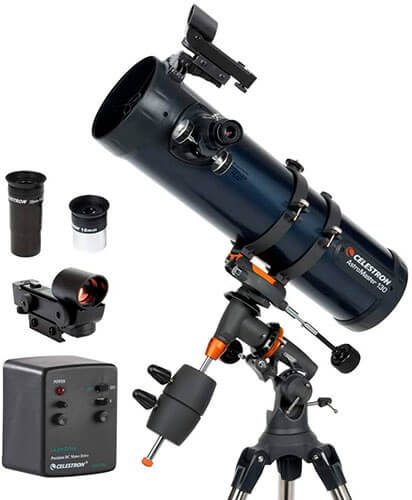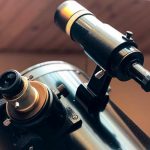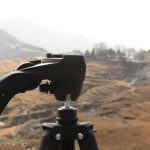Celestron AstroMaster 130EQ Newtonian Telescope Review
The Celestron AstroMaster 130EQ Newtonian telescope is the top-of-the-line version of the manufacturer’s Astromaster telescope line. This is a real telescope for those who want to take astronomy seriously but are still beginning the journey.
Briefly, the Astromaster 130EQ is a Newtonian reflector telescope with a 130mm (5 inches) primary mirror with a focal length of 650mm (25.5 inches).
Buying a telescope that offers the best value for money is not as straightforward as many think; there are numerous choices, and the information can quickly get overwhelming. That’s where this review of the Celestron Astromaster 130EQ will help you decide if this telescope is the one you should buy.
Celestron 130EQ Specifications and What’s In The Box
Specifications:
- Newtonian reflector
- 130mm (5-inch) aperture
- f/5 focal ratio
- 307x highest magnification
- 20 pounds weight assembled
130EQ What’s In The Box:
- Optical tube assembly (OTA)
- Mounting rings & dovetail bar
- Red dot finder
- Equatorial mount with a counterweight
- Lightweight steel legs
- Accessory tray
- 10mm & 20mm eyepieces
- Manual
- Starry night astronomy software
Celestron Astromaster 130EQ OTA Assembly
The Optical tube assembly on the 130EQ is simple because there’s nothing to assemble. The optical tube has plastic fitments on each end with preassembled mounting rings and a dovetail bar. At the end of the tube, there are screw adjustments for the primary mirror; these screws are for collimating the telescope.
Collimation will need doing before you come to use the scope for viewing; otherwise, your images will not be clear and sharp. Collimating isn’t that difficult, and you’re sure to find videos online that go through the process.
Collimating the telescope is a positive thing because you could have chosen another telescope of a similar price that only has a fixed primary mirror. In theory, any severe jarring of the optical tube could knock the telescope out of collimation; then, you have a big problem. However, you might be lucky and find the telescope already collimated right out of the box. Even transporting it hasn’t knocked it out of collimation.
The 130EQ has a decent focuser, with the focusing knobs being aluminium partly covered in rubber to get a good grip.
Celestron 130EQ Primary Mirror
Newtonian telescopes always feature either spherical or parabolic-shaped mirrors. The 130EQ has a spherical mirror; there was a time when the telescope shipped with a parabolic mirror, but not anymore.
Spherical mirrors are a cheaper design and can display some aberration; however, on a scope with a 130mm primary mirror, it’s unlikely a beginner would be able to tell any difference between having a mirror that’s parabolic or spherical.
Astromaster 130EQ Focal Ratio
To get a telescope’s focal ratio divide the focal length by the aperture; in the case of the Astromaster 130EQ, this gives us a focal ratio of f/5.
What does an f/5 focal ratio mean when you’re buying a telescope, and is it important? The focal ratio determines how “fast” or “slow” the telescope. What this means is the faster the scope, the brighter the images. Telescopes with focal ratios below f/7 are typically seen as “fast” scopes, whereas any scope over f/9 is “slow.”
The Astromaster’s f/5 focal ratio will allow you to view deep sky objects such as nebulas and galaxies that are dimmer.
Astromaster 130 EQ Equatorial Mount with Steel Legs
The mount is robust enough to hold the OTA, and using the two fine adjustments is excellent and smooth. However, trying to polar align the EQ mount is another story. It shouldn’t concern you too much; all you need to do is face the mount pointing north and adjust the latitude for your location. There’s no level bubble on the mount’s head, so it makes polar aligning very difficult.
Ensure you balance the telescope correctly using the counterweight; once you manage that, the telescope is stable enough. But try not to touch the optical tube assembly when viewing because the telescope is very sensitive, and there’s a significant shake.
There are much better EQ mounts than the AstroMaster’s, but it’s adequate considering this telescope is for beginners.
If you find the mount too shaky for your liking, don’t overextend the legs and hang a heavy item between the mount’s legs. Because they are steel legs, you will be able to hang something where the legs connect; this is one advantage of having steel legs instead of more flimsy aluminium legs.
Celestron AstroMaster 130 EQ Motorized Upgrade
The 130 EQ is a manual focus and features two slow-motion control knobs that allow you to make exact adjustments. Having to make adjustments as you’re viewing can be fiddly and pretty quickly get tedious. As the Earth rotates, celestial objects drift across the sky and move out of the eyepiece unless you make these precise movements.
Using the EQ mount with a motor drive will help eliminate this issue. Once you find the object you want to view, switch on the drive, and the telescope will do the tracking for you; handsfree.
You cannot do this with the 130 EQ, but you can do one of two things. Buy the motor as additional kit or buy the telescope that automatically comes with the motor. Should you want to go with the second option, look for this telescope Celestron AstroMaster 130EQ-MD Newtonian Telescope.
AstroMaster 130 EQ Included Eyepieces
The telescope accessories include two eyepieces, one 10mm and the other 20mm. The 10mm is an intermediate-quality metal eyepiece that offers 65x magnification. Neither eyepiece is anything to write home about but the 20mm erecting eyepiece is not much use except for viewing the moon. An erecting eyepiece places the images the right way up, unlike standard eyepieces where images are upside down.
Celestron includes this eyepiece to market the telescope as multipurpose; for example, if you want to use the telescope for bird watching during the day, naturally, you need the image the right way. I don’t believe it adds anything to the scope, and don’t buy it for this purpose.
The 10mm eyepiece is adequate for when you’re starting, but you’ll very quickly want to buy better eyepieces. Quality eyepieces and a Barlow lens with a 5-inch aperture will be a gigantic leap in your viewing pleasure.
AstroMaster 130EQ Starry Night Astronomy Software
For all beginners, the Starry Night Astronomy software is an excellent bonus. The software will help you find the objects you want to view, making life so much easier. The software also has a real-time sky projection if you’re going to see things currently in your viewing vicinity and their location.
What Will You See With The AstroMaster 130 EQ?
Having a “fast” telescope with a low focal ratio of f/5 means the telescope is best suited for viewing large areas of the night sky rather than specific objects.
Naturally, you can still view our moon and planets such as Jupiter and other planets in our solar system, but focusing will be a lot trickier. Larger objects farther away will be much brighter and more straightforward to observe.
Having a decent size aperture of 130mm gives the telescope a lot of light-gathering capability. Viewing is dependent on how much light a telescope can gather, especially reflectors.
The 130EQ has a magnification high of 307x, which means it can gather 345x more light than by looking with the naked eye. If you want the best from this telescope, you should view star clusters, nebula, intergalactic dust clouds, distant stars, and other galaxies. It’s fascinating to look through a telescope and view galaxies that we will probably never be able to reach any other way.
Using The Celestron 31045 AstroMaster 130 EQ Reflector Telescope: Pros & Cons
Pros:
- The Astromaster 130 EQ has excellent optics, and coupled with a large aperture, the reflector telescope offers some fantastic views of deep space objects.
- The price point is very competitive, and while money has been saved on the mount and the eyepieces, Celestron have produced an excellent telescope. For beginners, it’s a tremendous starter scope; the user can buy additional eyepieces, a Barlow lens, and a new mount as they progress.
- The 130 EQ is a beautiful-looking telescope, the black and orange color combination is one of my favorites, and it stands out a mile.
- Weighing in at only 26.5lbs, the AstroMaster 130 EQ is a lightweight and portable telescope and can travel with you wherever you might want to go to do your viewing.
Could Make Improvements:
- The mount could be so much better; it’s a bit shaky, and the transitions could be smoother; plus, the declination adjustment is not too good. But with the cost of new mounts, it’s definitely good enough to be going on with.
- The tripod is made of lightweight steel tubing and is not as stable as I would prefer once the telescope is on top.
- The user manuals, software, and hardcopy are too vague and don’t particularly help beginners with setup and user instructions.
Final Thoughts
The Celestron AstroMaster 130EQ is undoubtedly worth getting and is ideally priced for the beginner. The telescope optics are excellent, and over time you can add a motorized drive, new eyepieces, a new mount, and buy a quality Barlow lens to enhance your viewing capabilities; it’s an excellent first telescope for new amateurs.





















